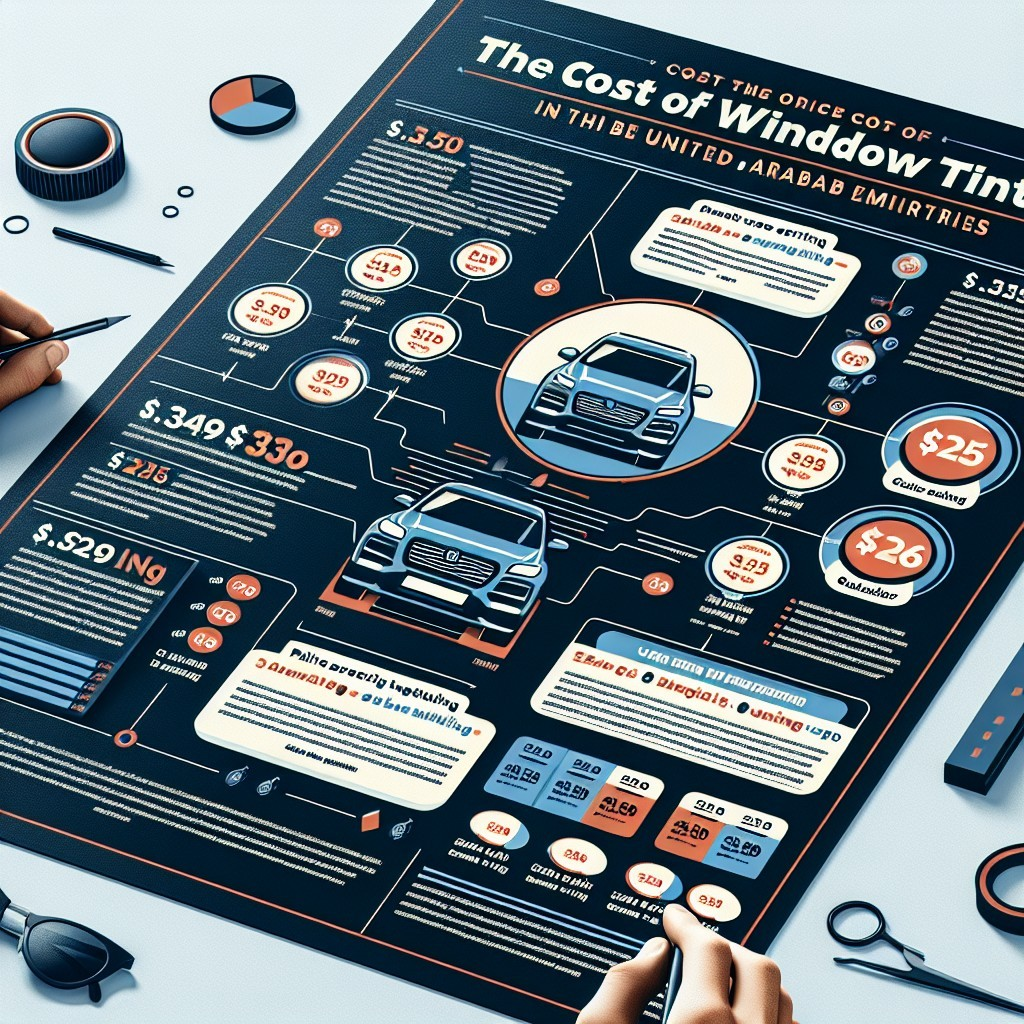As a car enthusiast or an everyday driver, you may have noticed the sleek, darkened windows of some vehicles on the road. This aesthetic appeal is not just for show; it’s the result of a process known as car window tinting. In this beginner’s guide, we’ll delve into the ins and outs of car window tinting, exploring its benefits, types, legal considerations, and maintenance tips.
Understanding Car Window Tinting
Car window tinting involves applying a thin film to the windows of a vehicle. This film is usually made from polyester and can vary in thickness and darkness. The primary purpose of tinting is not only to enhance the appearance of the car but also to provide numerous functional benefits.
Why Tint Your Car Windows?
- UV Protection: One of the most significant benefits of window tinting is its ability to block harmful ultraviolet (UV) rays. This protection can help prevent skin damage and reduce the risk of skin cancer for drivers and passengers.
- Heat Reduction: Tinted windows can significantly reduce the amount of heat entering your vehicle. This can keep your car cooler, reducing the need for air conditioning and improving fuel efficiency.
- Privacy and Security: Tinted windows provide a level of privacy that can deter potential thieves. With reduced visibility into the car, valuables are less likely to be targeted.
- Glare Reduction: Tinted films can minimize glare from the sun and headlights, making driving safer and more comfortable.
- Enhanced Aesthetics: Beyond functionality, window tinting adds a sleek and stylish look to any vehicle, making it stand out on the road.
Types of Window Tinting Films
When considering window tinting, it’s essential to understand the different types of films available:
- Dyed Window Film: This type of film contains dye that absorbs heat. It’s an economical option but may not offer the same longevity as others.
- Metalized Window Film: This film contains tiny metal particles that reflect heat and UV rays. It’s more durable and provides better performance than dyed films.
- Carbon Window Film: Carbon films block UV rays and heat without the shiny appearance of metal. They offer excellent glare reduction and are highly durable.
- Ceramic Window Film: The most advanced type, ceramic films provide superior performance without interfering with electronic devices. They offer excellent heat and UV protection while maintaining visibility.
Legal Considerations
Before you rush to tint your windows, it’s crucial to be aware of the legal restrictions in your area. Most states have laws governing the extent to which windows can be tinted, particularly for front windshields and side windows. Typically, these laws specify the allowable VLT (Visible Light Transmission) percentage, which indicates how much light can pass through the tinted windows. Always check your local regulations to ensure compliance and avoid hefty fines.
Maintenance Tips for Tinted Windows
Once you’ve had your windows tinted, proper maintenance is essential to prolong the life of the film:
- Wait Before Cleaning: Allow the tint to cure for at least a week before cleaning the windows to ensure the adhesive bonds properly.
- Use Gentle Cleaners: Avoid ammonia-based cleaners, as they can damage the tint. Instead, use a mild soap solution or a cleaner specifically designed for tinted windows.
- Soft Cloth Only: When cleaning, utilize a soft microfiber cloth to prevent scratching the film.
Car window tinting is more than just a trendy modification; it offers numerous benefits that can enhance comfort, safety, and privacy. By understanding the types of films available, the legal considerations involved, and maintenance tips, you can make informed decisions about tinting your car windows. Whether you’re looking to improve your vehicle’s aesthetics or protect your health, window tinting is a worthwhile investment for any driver.
Choosing the Right Tint for Your Vehicle
When it comes to selecting the right tint for your vehicle, there are a few factors to consider beyond just aesthetics. Think about your driving habits, the climate in your area, and how much privacy you desire. For instance, if you live in a sunny region, a ceramic film may be your best bet for maximum heat rejection. Conversely, if you’re primarily concerned with looks and slight heat reduction, a dyed film might suffice. Always consult with a professional installer who can guide you through the options tailored to your specific needs.
Installation Process: What to Expect
The installation of window tinting can be a meticulous process, and while DIY kits are available, professional installation is often recommended. Here’s what to expect during the process:
- Preparation: The technician will clean your windows thoroughly to ensure the film adheres properly.
- Measurement and Cutting: Precise measurements of each window are taken, and the film is cut to fit perfectly.
- Application: The film is applied with a special solution that allows for adjustment before it bonds.
- Trimming and Finishing: Once the film is in place, excess material is trimmed, and the technician will ensure everything is smooth and free of bubbles.
- Curing: You’ll typically need to allow the tint to cure for a few days, during which you should avoid rolling down the windows.
Common Myths About Window Tinting
As with many automotive modifications, several myths surround window tinting. Let’s debunk a few:
- Myth 1: Tinted windows are illegal everywhere.
Truth: Legal limits vary by state and country. Always research local laws. - Myth 2: Window tinting is only about looks.
Truth: The benefits extend beyond aesthetics to safety, security, and comfort. - Myth 3: All window films are the same.
Truth: The quality of the film varies significantly, impacting durability and performance.
Cost Considerations
The cost of window tinting can vary widely, depending on several factors including the type of film, the size of your vehicle, and the complexity of the installation. On average, you can expect to pay anywhere from $100 to $500 for a professional tint job. While it may seem like a considerable investment, the long-term benefits, such as reduced cooling costs and increased privacy, can make it worthwhile.
Ultimately, the decision to tint your car windows comes down to personal preference and lifestyle. If you value comfort, privacy, and UV protection, window tinting is an investment that pays off in more ways than one. As you navigate the options, remember to consult local regulations, choose a reputable installer, and select a film that aligns with your needs. With the right tint, you can enjoy a cooler, safer, and more stylish ride.
Continuing our exploration of the fascinating world of car window tinting, let’s delve deeper into the nuances that can help you make an informed choice. Whether you’re a first-time buyer or simply curious about enhancing your vehicle, understanding the subtleties of window tinting can empower you to elevate your driving experience.
Benefits Beyond Aesthetics
While the sleek appearance of tinted windows is often what first attracts car owners, the advantages extend far beyond just looks. Here are some additional benefits worth considering:
- Improved Safety: Window tints can hold shattered glass together, thereby reducing the risk of injury during an accident or break-in.
- Increased Resale Value: A well-tinted vehicle is often perceived as more desirable, which can lead to a better resale value when it’s time to upgrade.
- Health Benefits: By blocking harmful UV rays, tinted windows can help protect your skin from sun damage, making your time spent in the car safer and healthier.
Choosing the Right Tint Percentage
One of the most critical decisions in the window tinting process is selecting the appropriate tint percentage. This percentage indicates how much light is allowed to pass through the windows. Here’s a quick guide:
- 5% Tint: Often referred to as “limo tint,” this offers maximum privacy but can significantly reduce visibility at night.
- 20% Tint: Balances privacy and visibility; it’s a popular choice among car enthusiasts.
- 35% Tint: Provides a moderate level of privacy while still allowing enough light for visibility.
- 50% and Above: Ideal for those who want to enhance comfort without compromising visibility. This tint allows a greater amount of light to enter but still reduces glare and UV exposure.
DIY vs. Professional Installation
The debate between DIY tinting and professional installation is a hot topic among car enthusiasts. While DIY kits might be more affordable, they often lack the quality and durability of professional-grade films. Here’s a breakdown of the pros and cons:
DIY Installation
- Pros: Cost-effective, flexible timing, and a sense of accomplishment.
- Cons: Higher chances of bubbles, creases, and premature peeling; often lacks warranty coverage.
Professional Installation
- Pros: Expertise in application, better quality materials, and warranty protection.
- Cons: Higher upfront cost and scheduling constraints.

Understanding the Installation Process
If you opt for professional installation, knowing what to expect can ease any apprehensions. The process generally involves several steps:
- Initial Consultation: Discuss your preferences, budget, and any concerns with the installer.
- Window Preparation: The technician will clean the windows thoroughly to eliminate dirt and debris, ensuring a smooth application.
- Film Application: The tint is applied carefully, using heat and pressure to ensure it adheres without bubbles.
- Curing Time: After installation, the tint needs time to cure. This typically ranges from a few days to a week, depending on the climate.
Common Misconceptions
As with any trend, misconceptions abound regarding window tinting. Here are a few common myths debunked:
- Myth: Tinted windows are only for luxury cars.
Truth: Any vehicle can benefit from tinting, regardless of its price point. - Myth: Tints will make your car too dark to see out of.
Truth: There are various shades available that allow for visibility while still providing protection. - Myth: Window tinting is a one-size-fits-all solution.
Truth: Each vehicle and owner’s needs are different, so customization is key.
So, are you ready to take the plunge into the world of window tinting? With the right knowledge and considerations, you can enhance not only your car’s look but also its functionality and your overall driving comfort.


I loved the breakdown of different types of window films. It really helped me decide what to choose for my car!
This article does a fantastic job explaining the benefits of car window tinting. I had no idea it could help with fuel efficiency!
I never thought about how much glare could affect my driving. This guide made me realize how important tinting is!
I appreciate the legal considerations mentioned in the article. It
The aesthetic benefits of window tinting are clear, but I appreciate the focus on safety features as well. Very informative!
Fantastic read! The maintenance tips were especially helpful. I want my tint to last as long as possible.
Great insights on UV protection! I’m definitely considering tinting my windows after reading this.
This guide is perfect for beginners like me. I feel much more confident about getting my car windows tinted now!